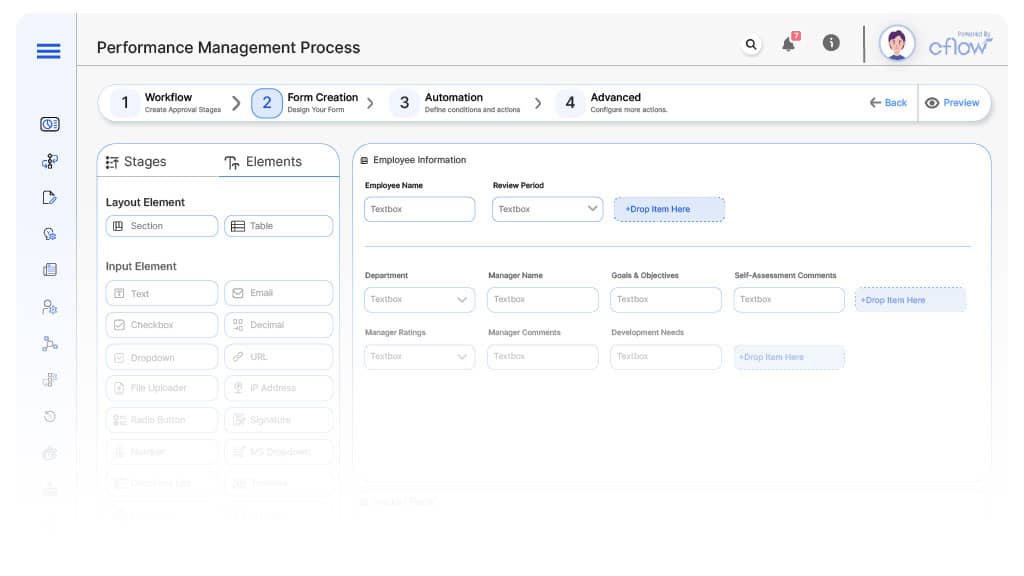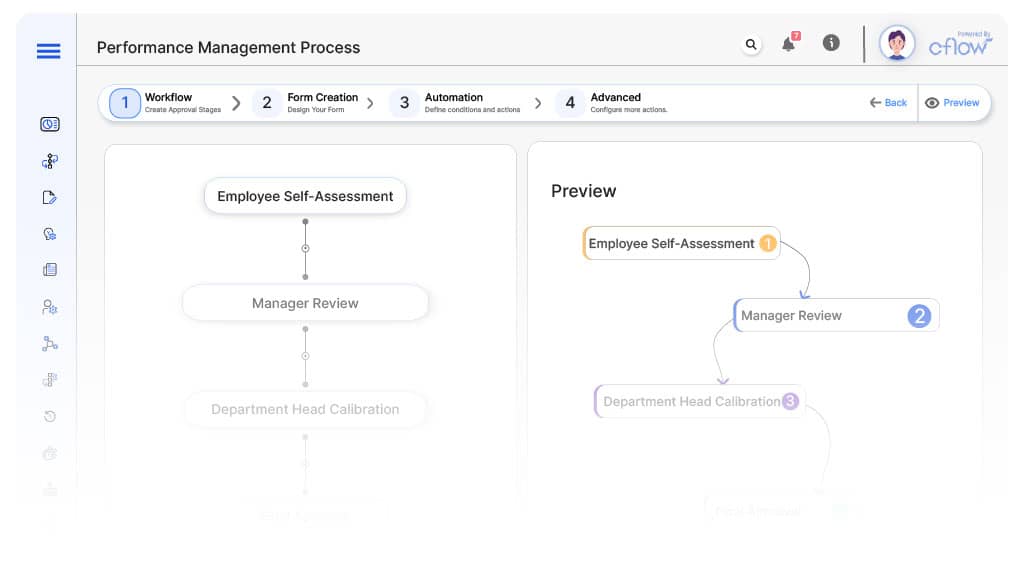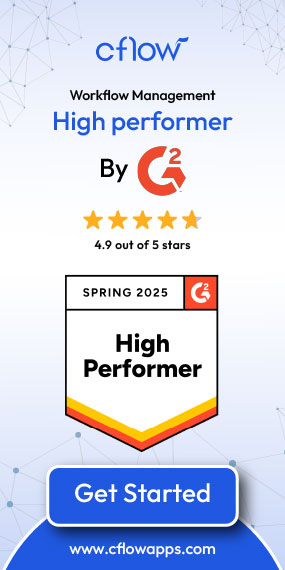- Cflow
- Performance Management Process Automation
Performance Management Process
Learn how Cflow streamlines Performance Management Process for HR teams at mid-sized organizations, step-by-step workflow, roles, form fields, approval logic, and real examples.

Clow Team

Performance management is a critical HR process that drives employee development, organizational alignment, and business results. Yet many companies still rely on outdated spreadsheets, inconsistent feedback, and infrequent reviews, resulting in misaligned goals, disengaged employees, and subjective appraisals. Recent industry research shows that 58% of organizations report employee dissatisfaction with existing performance review processes due to lack of transparency and delayed feedback cycles.
Manually coordinating performance reviews leads to missed evaluation deadlines, inconsistent rating scales, and incomplete feedback documentation. HR teams struggle to track review completion, manage calibration meetings, and enforce policy compliance across departments. This guide walks you through exactly how Cflow automates Performance Management Process, from form design to final sign-off.
Manually coordinating performance reviews leads to missed evaluation deadlines, inconsistent rating scales, and incomplete feedback documentation. HR teams struggle to track review completion, manage calibration meetings, and enforce policy compliance across departments. This guide walks you through exactly how Cflow automates Performance Management Process, from form design to final sign-off.
Table of Contents
What Is Performance Management Process?
The Performance Management Process is a structured approach to setting goals, monitoring progress, providing feedback, and evaluating employee performance over specific review periods. It ensures that employee objectives align with organizational strategy while fostering continuous development.
In simple terms, performance management functions like a GPS, employees need clear destinations (goals), regular course corrections (feedback), and checkpoints (reviews) to stay on track. The process includes goal setting, mid-year reviews, self-assessments, manager evaluations, HR calibration, and final ratings.
Recent industry research shows that organizations with automated performance management systems see 30% higher employee engagement and significantly reduce appraisal cycle times. Without standardized workflows, performance reviews become subjective, error-prone, and demotivating.
In simple terms, performance management functions like a GPS, employees need clear destinations (goals), regular course corrections (feedback), and checkpoints (reviews) to stay on track. The process includes goal setting, mid-year reviews, self-assessments, manager evaluations, HR calibration, and final ratings.
Recent industry research shows that organizations with automated performance management systems see 30% higher employee engagement and significantly reduce appraisal cycle times. Without standardized workflows, performance reviews become subjective, error-prone, and demotivating.
Why Performance Management Process Is Important for HR Teams
Organizational Alignment
Ensures employee goals directly contribute to business objectives, driving measurable outcomes.
Fair & Consistent Evaluation
Standardizes rating scales, feedback forms, and evaluation criteria, reducing bias and favoritism.
Employee Growth & Retention
Facilitates continuous feedback and development discussions, boosting engagement and career satisfaction.
Key Benefits of Automating Performance Management Process with Cflow
- Centralized Goal & Review Tracking : Cflow consolidates all performance goals, review forms, feedback notes, and ratings into one central platform. Managers and HR can monitor real-time progress across departments, ensuring that no evaluation falls through the cracks. Employees always know where they stand, which goals are pending, and when reviews are due, improving accountability and transparency.
- Dynamic Review Templates : Cflow allows HR to create role-specific review forms with dynamic sections based on employee level, department, or role type. For example, leadership roles may include competency ratings while junior staff focus on technical KPIs. Conditional fields ensure only relevant sections appear, streamlining manager workloads and improving evaluation relevance.
- Multi-Level Review & Calibration : Cflow routes reviews through multiple stages: self-assessment, manager evaluation, department head review, and HR calibration. Each stakeholder receives assigned tasks at the appropriate stage. Calibration workflows ensure consistency across departments, allowing HR to normalize ratings before final approvals. Feedback loops allow reviewers to return forms for clarification or further input before sign-off.
- Real-Time Progress Monitoring : HR gains visibility into review completion status across the organization. Cflow’s dashboards highlight overdue tasks, pending reviews, and calibration bottlenecks. Automated reminders prompt reviewers to act before deadlines. This ensures review cycles stay on track and eliminates last-minute scrambling, while enabling leadership to track organizational performance trends in real-time.
- Policy Enforcement & Timelines : Cflow enforces company review timelines and policies. Employees cannot submit incomplete forms or bypass required fields. Managers must complete competency ratings before submitting. HR defines blackout dates, review cycles, and rating scales centrally, ensuring uniformity across the entire organization. This eliminates inconsistencies, protects against legal disputes, and improves audit readiness.
- Audit Trail & Compliance : Every rating, comment, adjustment, and sign-off is time-stamped and archived. HR can easily retrieve historical review data for internal audits, promotions, or legal inquiries. The complete audit trail ensures transparency and defensibility in case of grievances or disputes over evaluation fairness, supporting compliance with labor regulations and corporate governance.
- Mobile Accessibility : Busy managers and employees can complete self-assessments, manager reviews, and HR approvals directly from their mobile devices. Cflow’s responsive design ensures that no reviews are delayed due to travel or scheduling conflicts. Mobile accessibility boosts completion rates, ensures timely feedback, and supports continuous performance management even in remote or hybrid work environments.
Get the best value for money with Cflow
User Roles & Permissions
Employee
- Responsibilities: Complete self-assessment, update goal progress, acknowledge final ratings.
- Cflow Permission Level: Submit Form.
- Mapping: Assigned to “Employees” group; access limited to personal reviews.
Manager
- Responsibilities: Conduct performance reviews, provide feedback, complete ratings, submit recommendations.
- Cflow Permission Level: Approve/Reject, Edit.
- Mapping: Assigned to “Managers” group; access to direct reports.
Department Head
- Responsibilities: Review manager submissions, add calibration input, approve or request adjustments.
- Cflow Permission Level: Approve/Reject.
- Mapping: Assigned to “Department Heads” group.
HR Officer
- Responsibilities: Oversee entire cycle, manage timelines, run calibration meetings, finalize ratings.
- Cflow Permission Level: Admin.
- Mapping: Assigned to “HR Team” group.
Compliance Auditor
- Responsibilities: Periodically review completed reviews for fairness and regulatory compliance.
- Cflow Permission Level: View Only.
- Mapping: Assigned to “Compliance” group.
Discover why teams choose Cflow
Form Design & Field Definitions

Field Label: Performance Review ID
- Type: Autonumber
- Logic/Rules: Unique ID auto-generated for each cycle.
- Auto-Populate: On submission.
Field Label: Employee Name
- Type: Text (Read-only)
- Auto-Populate: Pulled from profile.
Field Label: Review Period
- Type: Dropdown (H1, H2, Annual)
- Auto-Populate: HR-defined.
Field Label: Department
- Type: Dropdown
- Auto-Populate: From profile.
Field Label: Manager Name
- Type: Text (Read-only)
- Auto-Populate: Pulled from reporting structure.
Field Label: Goals & Objectives
- Type: Repeater Table
- Logic/Rules: List each goal, weightage, and progress.
Field Label: Self-Assessment Comments
- Type: Text Area
- Logic/Rules: Mandatory for submission.
Field Label: Manager Ratings
- Type: Dropdown (1-5 scale)
- Logic/Rules: Mandatory.
Field Label: Manager Comments
- Type: Text Area
- Logic/Rules: Mandatory if rating < 3.
Field Label: Development Needs
- Type: Text Area
- Logic/Rules: Capture training recommendations.
Field Label: Department Head Comments
- Type: Text Area
- Logic/Rules: Visible only after manager submission.
Field Label: HR Calibration Notes
- Type: Text Area
- Logic/Rules: Visible only to HR.
Field Label: Final Rating
- Type: Calculated Field (averages adjusted scores)
- Logic/Rules: Auto-calculation after calibration.
Field Label: Employee Acknowledgement
- Type: Checkbox
- Logic/Rules: Required to complete final stage.
Transform your Workflow with AI fusion
Approval Flow & Routing Logic

Submission → Employee Self-Assessment
- Status Name: Self-Assessment Pending
- Notification Template: “Hi {Employee}, your self-assessment for {Review Period} is now open. Please complete.”
- On Approve: Moves to Manager Review.
- On Reject: N/A.
- Escalation/Reminder Rules: Reminder after 5 days; escalate to Manager after 7 days.
Employee Self-Assessment → Manager Review
- Status Name: Pending Manager Review
- Notification Template: “Hi {Manager}, self-assessment for {Employee} is submitted. Please complete your review.”
- On Approve: Moves to Department Head Calibration.
- On Reject: Return to Employee for clarification.
- Escalation/Reminder Rules: Reminder after 5 days; escalate to HR after 7 days.
Manager Review → Department Head Calibration
- Status Name: Pending Department Calibration
- Notification Template: “Hi {Department Head}, manager review for {Employee} submitted. Please review and calibrate.”
- On Approve: Moves to HR Calibration.
- On Reject: Returns to Manager for rework.
- Escalation/Reminder Rules: Reminder after 3 days; escalate to HR Lead after 5 days.
Department Head Calibration → HR Calibration
- Status Name: Pending HR Finalization
- Notification Template: “Hi HR, department calibration for {Employee} completed. Please finalize.”
- On Approve: Moves to Employee Acknowledgement.
- On Reject: Returns to Department Head.
- Escalation/Reminder Rules: Reminder after 3 days; escalate to HR Director after 5 days.
HR Calibration → Employee Acknowledgement
- Status Name: Awaiting Employee Acknowledgement
- Notification Template: “Hi {Employee}, your performance review is complete. Please acknowledge to close.”
- On Approve: Moves to Review Closed.
- On Reject: Returns to HR for dispute resolution.
- Escalation/Reminder Rules: Reminder after 3 days.
Final → Review Closed
- Status Name: Review Closed
- Notification Template: “Performance review cycle for {Employee} successfully closed and archived.”
Transform your AI-powered approvals
Implementation Steps in Cflow
Create a new workflow
Go to Cflow Dashboard → Workflows → Add New → Name it “Performance Management Process Automation
Design the form
Use Form Builder to add all fields defined in Form Design & Field Definitions. Configure conditional logic for role-based field visibilityUse Form Builder to add fields from Form Design & Field Definitions. Set conditional logic for Leave Type and document uploads.
Set up User Roles/Groups
Navigate to Settings → User Roles → Create groups: “Employees,” “Managers,” “Department Heads,” “HR Team,” “Compliance.” Assign appropriate users.
Build the process flow diagram
In Workflow Builder, add nodes for: Submission → Self-Assessment → Manager Review → Department Calibration → HR Calibration → Acknowledgement → Review Closed. Insert decision gateways for escalations.
Configure notifications
Under each node, define email/SMS templates as specified in Approval Flow & Routing Logic. Set escalation reminders.
Set conditional logic
Apply visibility rules based on review cycle, job roles, or department.
Save and publish workflow
Click Save → Publish to make live.
Test with a sample request
Log in as test employee; submit self-assessment. Verify all approval stages, notifications, escalations.
Adjust based on feedback
Update form fields, routing logic, and reminders as needed.
Go live: Assign real participants and conduct manager, HR, and employee training.
Example Journey: “John’s Onboarding”
David from Sales starts his H1 self-assessment for Review ID PR-7891. Manager Laura completes ratings and recommends training. Department Head Mark calibrates team ratings. HR finalizes David’s overall score at 4.0. David acknowledges completion on April 15th via mobile. The process closes with a full audit trail archived.
FAQ's
How long does it take to set up Performance Management Process in Cflow?
Full configuration including form design, routing, and calibration flows can be completed in 3–5 business days.
Can Cflow handle multiple review cycles per year?
Yes. Cflow fully supports annual, semi-annual, and quarterly cycles.
Does Cflow integrate with HRIS or LMS platforms?
Absolutely. Cflow integrates with leading HRIS systems and LMS platforms for centralized employee data and development plans.
Can employees complete reviews via mobile?
Yes. Cflow’s mobile-friendly interface enables employees and managers to complete reviews anywhere, anytime.
Unleash the full potential of your AI-powered Workflow

Related Templates
Explore More Process Automations
Performance Management Process Automation
November 18, 2025
Cflow Process Process Automation Performance Management Process Learn how Cflow streamlines Performance Management Process for…
Team-Building Budget Automation
November 18, 2025
Cflow Process Process Automation Team-Building Budget Automation Learn how Cflow streamlines Team-Building Budget Approval Process…
Exit Interview Authorization Automation
November 17, 2025
Cflow Process Process Automation Exit Interview Authorization Automation Learn how Cflow streamlines the Exit Interview…
Work Visa Application Automation
November 18, 2025
Cflow Process Process Automation Work Visa Application Automation Learn how Cflow streamlines Work Visa Application…
Flexible Work Arrangement Automation
November 17, 2025
Cflow Process Process Automation Employee Equipment Request Automation Learn how Cflow streamlines Flexible Work Arrangement…
Training Budget Approval Automation
November 18, 2025
Cflow Process Process Automation Training Budget Approval Automation Learn how Cflow streamlines Training Budget Approval…
